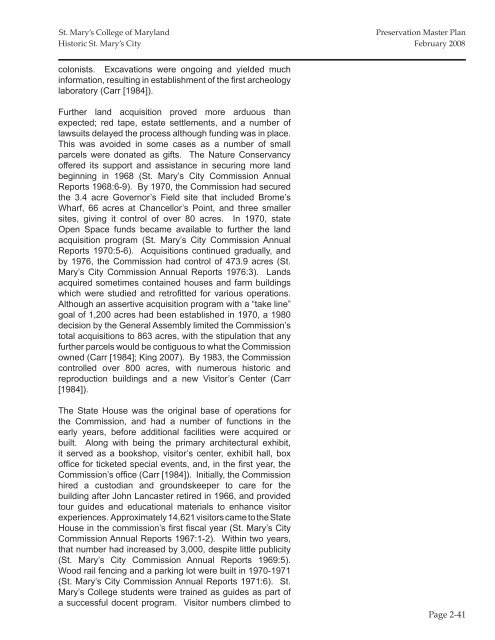St. Mary's College of Maryland Preservation Master Plan
St. Mary's College of Maryland Preservation Master Plan
St. Mary's College of Maryland Preservation Master Plan
- No tags were found...
You also want an ePaper? Increase the reach of your titles
YUMPU automatically turns print PDFs into web optimized ePapers that Google loves.
<strong>St</strong>. Mary’s <strong>College</strong> <strong>of</strong> <strong>Maryland</strong><strong>Preservation</strong> <strong>Master</strong> <strong>Plan</strong>Historic <strong>St</strong>. Mary’s City February 2008colonists. Excavations were ongoing and yielded muchinformation, resulting in establishment <strong>of</strong> the first archeologylaboratory (Carr [1984]).Further land acquisition proved more arduous thanexpected; red tape, estate settlements, and a number <strong>of</strong>lawsuits delayed the process although funding was in place.This was avoided in some cases as a number <strong>of</strong> smallparcels were donated as gifts. The Nature Conservancy<strong>of</strong>fered its support and assistance in securing more landbeginning in 1968 (<strong>St</strong>. Mary’s City Commission AnnualReports 1968:6-9). By 1970, the Commission had securedthe 3.4 acre Governor’s Field site that included Brome’sWharf, 66 acres at Chancellor’s Point, and three smallersites, giving it control <strong>of</strong> over 80 acres. In 1970, stateOpen Space funds became available to further the landacquisition program (<strong>St</strong>. Mary’s City Commission AnnualReports 1970:5-6). Acquisitions continued gradually, andby 1976, the Commission had control <strong>of</strong> 473.9 acres (<strong>St</strong>.Mary’s City Commission Annual Reports 1976:3). Landsacquired sometimes contained houses and farm buildingswhich were studied and retr<strong>of</strong>itted for various operations.Although an assertive acquisition program with a “take line”goal <strong>of</strong> 1,200 acres had been established in 1970, a 1980decision by the General Assembly limited the Commission’stotal acquisitions to 863 acres, with the stipulation that anyfurther parcels would be contiguous to what the Commissionowned (Carr [1984]; King 2007). By 1983, the Commissioncontrolled over 800 acres, with numerous historic andreproduction buildings and a new Visitor’s Center (Carr[1984]).The <strong>St</strong>ate House was the original base <strong>of</strong> operations forthe Commission, and had a number <strong>of</strong> functions in theearly years, before additional facilities were acquired orbuilt. Along with being the primary architectural exhibit,it served as a bookshop, visitor’s center, exhibit hall, box<strong>of</strong>fice for ticketed special events, and, in the first year, theCommission’s <strong>of</strong>fice (Carr [1984]). Initially, the Commissionhired a custodian and groundskeeper to care for thebuilding after John Lancaster retired in 1966, and providedtour guides and educational materials to enhance visitorexperiences. Approximately 14,621 visitors came to the <strong>St</strong>ateHouse in the commission’s first fiscal year (<strong>St</strong>. Mary’s CityCommission Annual Reports 1967:1-2). Within two years,that number had increased by 3,000, despite little publicity(<strong>St</strong>. Mary’s City Commission Annual Reports 1969:5).Wood rail fencing and a parking lot were built in 1970-1971(<strong>St</strong>. Mary’s City Commission Annual Reports 1971:6). <strong>St</strong>.Mary’s <strong>College</strong> students were trained as guides as part <strong>of</strong>a successful docent program. Visitor numbers climbed toPage 2-41
















